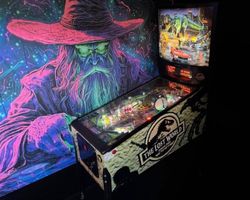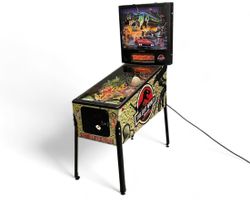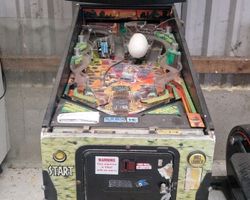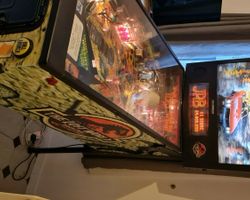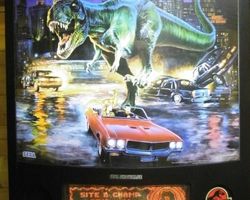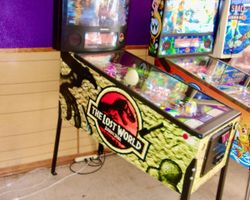The Lost World Jurassic Park
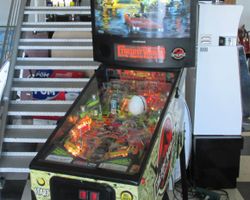
Average Prices: USD $900 to $2,500
Produced: June, 1997
Machine Type: Solid State Electronic
MPU: Sega/Stern Whitestar
Players: 6
Design by: John Borg
Art by: Morgan Weistling
Mechanics by: John Borg, Rob Hurtado
Software by: Neil Falconer, Orin Day
"The Lost World Jurassic Park," released by Sega Pinball, Inc. in June 1997, transported players into the perilous world of Isla Sorna, the "Site B" where dinosaurs roamed free. As a direct thematic sequel to the blockbuster film, this pinball machine aimed to capture the intensity and adventure of the cinematic experience, following the narrative threads of the second installment in the dinosaur saga. Produced by the United States-based Sega Pinball, Inc., the machine was one of the titles built on the robust Whitestar MPU platform, known for its reliability and feature-rich capabilities.
The design and production of "The Lost World Jurassic Park" involved a team of seasoned pinball creators. John Borg, a designer known for his intricate layouts and innovative mechanics, spearheaded the machine's overall design, including its mechanical systems. The visual identity was crafted by artist Morgan Weistling, whose work aimed to immerse players in the lush, dangerous jungle environments and capture the essence of the film's creatures. Brian Schmidt contributed significantly to the auditory landscape, composing the music and sound effects, including a remixed version of the iconic movie theme that plays throughout the game. Neil Falconer and Orin Day were responsible for the software development, bringing the rules and animations to life. With a production run of just 600 units, "The Lost World Jurassic Park" was a relatively limited release, making it a distinct piece in pinball history. Among its unique elements, the machine featured custom speech performed by actors Jeff Goldblum and Richard Attenborough, lending authenticity to the callouts. An interesting visual secret lay within the Skill Shot Video Mode, where players might occasionally spot an unexpected cameo from E.T., adding a layer of meta-referential amusement for those paying close attention.
The playfield of "The Lost World Jurassic Park" is defined by its interactive features and a layout designed to encourage fluid, rapid play. Central to its allure are two unique electromechanical toys: the "Snagger" and the "Egg" with its baby T-Rex. The Snagger, an armored truck-like device, is a prominent feature positioned in the upper playfield. It actively engages with gameplay by picking up and locking balls, a critical function for initiating multiball sequences. This mechanical arm extends, grasps the ball, and holds it out of play, creating anticipation before releasing it into action. The Egg toy, located on the right side of the playfield, is another captivating element. It houses a miniature baby T-Rex, which is revealed as the egg opens during specific game modes, adding a visual flourish that directly ties into the film's narrative. An optional 3-D backglass was also available, providing an added layer of visual depth to the machine's overall presentation. These signature features, particularly the Snagger's direct interaction with the ball, serve to enhance the player's immersion, making the playfield feel like a living, dynamic environment where prehistoric creatures and advanced technology coexist.
The playfield layout of "The Lost World Jurassic Park" follows a "fan" design, characterized by its multiple shots fanning out from the flippers, encouraging a fast-paced game. Key shots include a left and right ramp, which are essential for various scoring opportunities and mode progression. Two rollunder spinners are strategically placed within the left and right loops, rewarding accurate shots with high-speed spins and points. The playfield also features three pop bumpers, positioned in the upper area, keeping the ball in frantic motion and contributing to bonus scores. A single drop target is a crucial element, as knocking it down grants access to the Snagger device, enabling ball locks for multiball. Three magnets are discreetly placed to manipulate ball movement, introducing unpredictable deflections and increasing the challenge. The artwork, a notable contribution from Morgan Weistling, extends across the playfield, cabinet, and backglass. The playfield art integrates elements from the film, aiming for a "movie feel" that captures the essence of the Jurassic Park universe. While some contemporary feedback noted concerns about pixelation in certain art elements, the overall aesthetic, combined with vibrant lighting, strove to create an immersive visual experience. The layout's design philosophy encourages players to master specific shots to advance through modes and accumulate points, fostering a balance between direct targeting and chaotic, high-energy play.
Gameplay in "The Lost World Jurassic Park" is structured around completing a series of objectives to reach the coveted "San Diego" wizard mode. The core progression involves successfully completing five distinct modes, each initiated by a multiball sequence: Site B, Raptor Two-ball, Mobile Lab, Baby T-Rex, and GPS. Crucially, modes are not merely activated but must be completed by hitting specific flashing targets or executing required shots during their respective multiballs. Failure to complete a mode means it must be restarted, adding a layer of challenge and strategic repetition.
For instance, the "Site B" mode requires spelling S-I-T-E-B using standup targets before hitting a flashing target during its multiball. "Baby T-Rex" involves three shots to the egg scoop, followed by collecting a value during a multiball. The "Mobile Lab" mode focuses on spelling T-R-E-X via inlanes and outlanes, then hitting spinners during a two-ball multiball. The "GPS" mode challenges players to hit the left and right ramps a set number of times, with increasing difficulty in subsequent GPS modes. Each of these mode-specific multiballs presents its own set of targets and objectives, providing distinct gameplay challenges.
Beyond mode progression, the machine features a main multiball initiated by locking three balls using the Snagger toy. During regular multiball stages, players aim for jackpots by hitting both ramps, then both loops, and finally the middle loop for the super jackpot. Scoring is further bolstered by a video-based skill shot at the start of each ball, where players guide a dinosaur foot to stomp on a human while avoiding spiky obstacles. "Jurassic Loops" award points for consecutive loop shots, and "Pop Awards" are given for every 25 hits on the pop bumpers. The "Smart Missile" feature, when collected, can either initiate a multiball or instantly collect jackpots during an active multiball, providing a strategic option for players. Additionally, a "More Time" standup target can extend the duration of active modes, offering a crucial lifeline in challenging sequences.
"The Lost World Jurassic Park" garnered a mixed but often passionate reception within the pinball community. Many players found the machine's gameplay to be exceptionally fast and smooth, with well-designed ramps that were satisfying to hit. The challenging nature of the game, particularly the requirement to complete modes rather than just activate them to reach the San Diego wizard mode, appealed to those seeking a demanding experience. The integration of the movie theme was generally praised, with the custom speech from Jeff Goldblum and Richard Attenborough adding to the thematic authenticity. The unique Snagger toy, despite sometimes slowing down gameplay, was often cited as a cool and innovative feature, along with the opening egg and animated baby T-Rex. The backglass art also received positive feedback for its design. For some, the machine presented a good value, often being available at a more accessible price point compared to other licensed titles.
However, the machine also faced considerable criticism. Its difficulty was a polarizing aspect; while some appreciated the challenge, others found it overly punishing and frustrating, leading to shorter game times. The rules were sometimes perceived as shallow or repetitive, with modes occasionally requiring similar shots repeatedly, and some found the scoring unbalanced. A common point of contention was the audio quality; the mono sound and lack of stereo capabilities, combined with what some perceived as annoying sound effects and callouts, detracted from the experience. Visually, the artwork, particularly on the playfield, was occasionally criticized for being pixelated or appearing less refined than other titles of the era. The unique curved backbox design, while distinctive, was not universally appreciated. Issues with reliability, particularly concerning the Snagger toy, were also noted, alongside general perceptions that the machine felt "cheap" or rushed compared to its Data East predecessor. Despite these criticisms, "The Lost World Jurassic Park" holds a place as an often overlooked or underrated title from the Sega Pinball era. Its challenging gameplay, unique toys, and strong theme integration have ensured its continued presence in the collections of players who appreciate a demanding and engaging pinball experience.
Sponsored Links
 Ebay Listings
Ebay Listings
 Auction Results
Auction Results
| Cost | Location | Date |
|---|---|---|
| GBP £2,047 |  Hastings, United Kingdom Hastings, United Kingdom |
03 June, 2025 |
| USD $3,500 |  Florida, United States Florida, United States |
24 May, 2025 |
| USD $2,000 |  Connecticut, United States Connecticut, United States |
28 January, 2025 |
| GBP £200 |  United Kingdom United Kingdom |
19 November, 2024 |
| GBP £2,200 |  Brockenhurst, United Kingdom Brockenhurst, United Kingdom |
12 March, 2023 |
| USD $3,250 |  New York, United States New York, United States |
28 September, 2022 |
| USD $7,590 |  Tennessee, United States Tennessee, United States |
16 July, 2022 |
| GBP £2,963 |  United Kingdom United Kingdom |
11 July, 2022 |
| USD $3,400 |  Indiana, United States Indiana, United States |
24 June, 2022 |
| GBP £2,450 |  Camborne, United Kingdom Camborne, United Kingdom |
15 February, 2022 |


Private Policy · Search Website · Contact Us
As an eBay Partner, we may earn a commission from qualifying purchases made through links on this site, at no additional cost to you.
All trademarks and copyrighted materials remain property of their respective owners. All other content copyright 2007 - 2025 Pinpedia.

